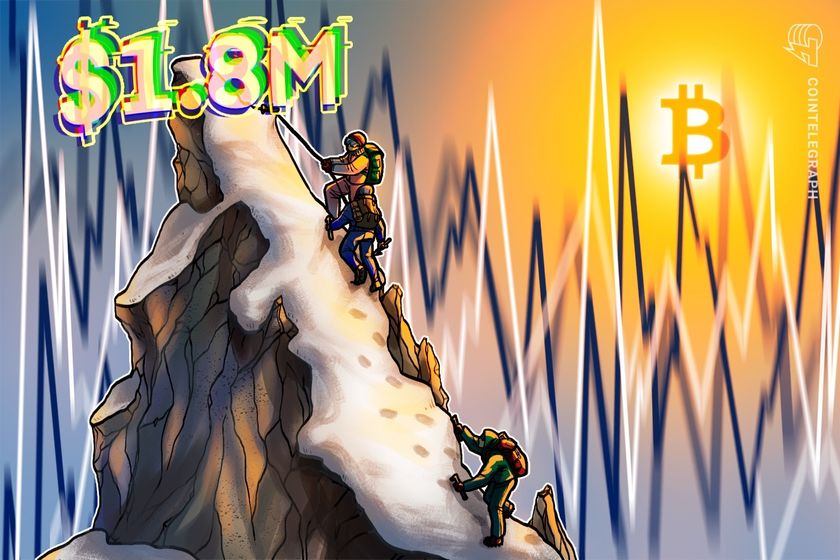Index strachu a chamtivosti
Top 7 růstů
| Kryptoměna | Změna za 24 hodin |
|---|---|
 Pi Network (pi) Pi Network (pi) | 24.47% |
 Bonk (bonk) Bonk (bonk) | 16.99% |
 Sei (sei) Sei (sei) | 13.78% |
 Bitcoin Cash (bch) Bitcoin Cash (bch) | 13.01% |
| 12.01% | |
 Sonic (prev. FTM) (s) Sonic (prev. FTM) (s) | 11% |
 Artificial Superintelligence Alliance (fet) Artificial Superintelligence Alliance (fet) | 9.75% |
Top 7 poklesů
| Kryptoměna | Změna za 24 hodin |
|---|---|
 MANTRA (om) MANTRA (om) | -1.17% |
 Tether Gold (xaut) Tether Gold (xaut) | -0.93% |
 LEO Token (leo) LEO Token (leo) | -0.8% |
 WhiteBIT Coin (wbt) WhiteBIT Coin (wbt) | -0.45% |
 USDC (usdc) USDC (usdc) | -0% |
 USDS (usds) USDS (usds) | -0.01% |
 Dai (dai) Dai (dai) | -0% |


Opinion by: Jack Lu, CEO of BounceBit
For years, crypto has promised a more open and efficient financial system. A fundamental inefficiency remains: the disconnect between US capital markets and Asia’s liquidity hubs.
The United States dominates capital formation, and its recent embrace of tokenized treasuries and real-world assets signals a significant step toward blockchain-based finance. Meanwhile, Asia has historically been a global crypto trading and liquidity hub despite evolving regulatory shifts. These two economies operate, however, in silos, limiting how capital can move seamlessly into digital assets.
This isn’t just an inconvenience — it’s a structural weakness preventing crypto from becoming a true institutional asset class. Solving it will cause a new era of structured liquidity, making digital assets more efficient and attractive to institutional investors.
The capital bottleneck holding crypto back
Inefficiency between US capital markets and Asian crypto hubs stems from regulatory fragmentation and a lack of institutional-grade financial instruments.
US firms hesitate to bring tokenized treasuries onchain because of evolving regulations and compliance burdens. Meanwhile, Asian trading platforms operate in a different regulatory paradigm, with fewer barriers to trading but limited access to US-based capital. Without a unified framework, cross-border capital flow remains inefficient.
Stablecoins bridge traditional finance and crypto by providing a blockchain-based alternative to fiat. They are not enough. Markets require more than just fiat equivalents. To function efficiently, they need yield-bearing, institutionally trusted assets like US Treasurys and bonds. Without these, institutional capital remains largely absent from crypto markets.
Crypto needs a universal collateral standard
Crypto must evolve beyond simple tokenized dollars and develop structured, yield-bearing instruments that institutions can trust. Crypto needs a global collateral standard that links traditional finance with digital assets. This standard must meet three core criteria.
First, it must offer stability. Institutions will not allocate meaningful capital to an asset class that lacks a robust foundation. Therefore, collateral must be backed by real-world financial instruments that provide consistent yield and security.
Recent: Hong Kong crypto payment firm RedotPay wraps $40M Series A funding round
Second, it must be widely adopted. Just as Tether’s USDt (USDT) and USDC (USDC) became de facto standards for fiat-backed stablecoins, widely accepted yield-bearing assets are necessary for institutional liquidity. Market fragmentation will persist without standardization, limiting crypto’s ability to integrate with broader financial systems.
Third, it must be DeFi-native. These assets must be composable and interoperable across blockchains and exchanges, allowing capital to move freely. Digital assets will remain locked in separate liquidity pools without onchain integration, preventing efficient market growth.
Without this infrastructure, crypto will continue to operate as a fragmented financial system. To ensure that both US and Asian investors can access tokenized financial instruments under the same security and governance standard, institutions require a seamless, compliant pathway for capital deployment.
Establishing a structured framework that aligns crypto liquidity with institutional financial principles will determine whether digital assets can truly scale beyond their current limitations.
The rise of institutional-grade crypto liquidity
A new generation of financial products is beginning to solve this issue. Tokenized treasuries, like BUIDL and USYC, function as stable-value, yield-generating assets, offering investors an onchain version of traditional fixed-income products. These instruments provide an alternative to traditional stablecoins, enabling a more capital-efficient system that mimics traditional money markets.
Asian exchanges are beginning to incorporate these tokens, providing users access to yields from US capital markets. Beyond mere access, however, a more significant opportunity lies in packaging crypto exposure alongside tokenized US capital market assets in a way that meets institutional standards while remaining accessible in Asia. This will allow for a more robust, compliant and scalable system that connects traditional and digital finance.
Bitcoin is also evolving beyond its role as a passive store of value. Bitcoin-backed financial instruments enable Bitcoin (BTC) to be restaked as collateral, unlocking liquidity while generating rewards. For Bitcoin to function effectively within institutional markets, however, it must be integrated into a structured financial system that aligns with regulatory standards, making it accessible and compliant for investors across regions.
Centralized decentralized finance (DeFi), or “CeDeFi,” is the hybrid model that integrates centralized liquidity with DeFi’s transparency and composability, and is another key piece of this transition. For this to be widely adopted by institutional players, it must offer standardized risk management, clear regulatory compliance and deep integration with traditional financial markets. Ensuring that CeDeFi-based instruments — e.g., tokenized treasuries, BTC restaking or structured lending — operate within recognized institutional frameworks will be critical for unlocking large-scale liquidity.
The key shift is not just about tokenizing assets. It’s about creating a system where digital assets can serve as effective financial instruments that institutions recognize and trust.
Why this matters now
The next phase of crypto’s evolution depends on its ability to attract institutional capital. The industry is at a turning point: Unless crypto establishes a foundation for seamless capital movement between traditional markets and digital assets, it will struggle to gain long-term institutional adoption.
Bridging US capital with Asian liquidity is not just an opportunity — it is a necessity. The winners in this next phase of digital asset growth will be the projects that solve the fundamental flaws in liquidity and collateral efficiency, laying the groundwork for a truly global, interoperable financial system.
Crypto was designed to be borderless. Now, it’s time to make its liquidity borderless, too.
Opinion by: Jack Lu, CEO of BounceBit.
This article is for general information purposes and is not intended to be and should not be taken as legal or investment advice. The views, thoughts, and opinions expressed here are the author’s alone and do not necessarily reflect or represent the views and opinions of Cointelegraph.


Changpeng “CZ” Zhao, former CEO of Binance, has denied claims that he agreed to provide evidence against Tron founder Justin Sun as part of a plea deal with the United States Department of Justice (DOJ).
In an April 11 report, The Wall Street Journal cited unnamed sources alleging that CZ had agreed to testify against Sun under the terms of his settlement with US prosecutors.
“As part of Zhao’s plea deal, he agreed to give evidence on Sun to prosecutors,” an “arrangement” that “hasn’t previously been reported,” the WSJ report stated, citing sources familiar with the matter.
“WSJ is really TRYING here. They seem to have forgotten who went to prison and who didn't,” Zhao wrote in an April 12 X post. “People who become gov witnesses don’t go to prison. They are protected. I heard someone paid WSJ employees to smear me.”
Source: Changpeng Zhao
CZ was sentenced to four months in prison in April 2024 for Anti-Money Laundering (AML) violations. He walked free from federal prison on Sept. 27 as the wealthiest person to ever serve a US prison sentence, with a $60 billion net worth at the time.
In a separate April 11 post, CZ claimed multiple individuals had warned him about the Journal’s intentions to publish what he described as a “hit piece.”
Source: Justin Sun
Sun said he was “not aware of the circulation rumors,” calling CZ his “mentor and close friend,” Cointelegraph reported on April 11.
Related: Trump kills DeFi broker rule in major crypto win: Finance Redefined
“Some players are lobbying against us again in the US” — CZ
CZ further speculated that the report could be linked to lobbying efforts against him and his former company.
“I also heard some rumors about some players ‘lobbying’ against us again in the US,” CZ said.
Cointelegraph has approached CZ for more details on the lobbying claims.
In November 2023, Zhao said that “FTX sought regulatory ‘crack down’ on Binance to increase market share,” citing a Federal Newswire report.
Related: New York bill proposes legalizing Bitcoin, crypto for state payments
Zhao’s comments come over a month after crypto donations raised influence concerns among industry participants.
Crypto firms spent over $134 million on the 2024 US elections in “unchecked political spending,” which presents some critical challenges, Cointelegraph reported on March 10.
Fairshake donations. Source: politicalaccountability.net
“While the companies making these contributions may be seeking a favorable regulatory environment, these political donations further erode public trust and expose companies to legal, reputational, and business risks that cannot be ignored,” according to a March 7 report by the Center for Political Accountability (CPA).
Magazine: XRP win leaves Ripple and industry with no crypto legal precedent set


An investor has sold a CryptoPunk non-fungible token (NFT) at a nearly $10 million realized loss, reflecting the continued decline in the once-booming blue-chip NFT market.
A whale, or large cryptocurrency investor, sold a CryptoPunk NFT for 4,000 Ether (ETH) worth more than $6 million at the time of writing.
The investor originally purchased the NFT for 4,500 ETH, or roughly $15.7 million, a year ago, according to blockchain analytics firm Lookonchain.
“Did he only lose 500 $ETH($774K)? No—he actually lost $9.73M!” Lookonchain wrote in an X post. “When he bought it, $ETH was trading at $3,509. By the time he sold, $ETH had dropped 57%,” the platform added.
CryptoPunk buy and sell. Source: Arkham Intelligence / Lookonchain
Despite the steep loss, the $6 million transaction still ranks as the largest NFT sale over the past 30 days, according to data from CryptoSlam.
Top NFT sales past 30 days. Source: CryptoSlam
The sale comes during a period of stagnation for NFTs, which have been lacking wider trader interest. NFT trading volume on Ethereum is down more than 53% over the past month, while Polygon’s NFT trading volume fell 41%.
CryptoPunks saw a temporary floor price surge of 13% after rumors that its owner, Yuga Labs, might be “in the process” of selling the collection’s intellectual property, Cointelegraph reported on Jan. 14.
Related: Sentient completes record 650K NFT mint for decentralized ‘loyal’ AI model
Blue-chip collections see steep drop
The top blue-chip NFT collections remain significantly down from their 2021 highs amid a lack of trading activity.
CryptoPunks currently have a floor price of about 43 ETH, or $68,000, down more than 61% from their record high of 113.9 ETH in October 2021.
CryptoPunks NFT floor price, all-time chart. Source: NFTpricefloor
The Bored Ape Yacht Club’s floor price is also down 89%, while the Mutant Ape Yacht Club collection is down 93%, NFTpricefloor data shows.
Related: Trump family memecoins may trigger increased SEC scrutiny on crypto
However, the Pudgy Penguin collection remains an outlier. It reached a new all-time high of over 25 Ether on Dec. 16, 2024, and amassed the highest sales volume of over $72 million in the first quarter of 2025, Cointelegraph reported on March 28.
Source: Yuga Labs
At the start of March, the US Securities and Exchange Commission closed its three-year investigation into Yuga Labs, an investigation initiated under former Chair Gary Gensler, which aimed to probe NFT creators and marketplaces, to see if some NFTs, such as fractional NFTs, were securities.
Magazine: Memecoin degeneracy is funding groundbreaking anti-aging research


Bitcoin remains on track to surpass $1.8 million by 2035 despite recent price corrections and waning investor appetite caused by ongoing global trade tensions, according to Joe Burnett, director of market research at Unchained.
Speaking during Cointelegraph’s Chainreaction live show on X, Burnett said that Bitcoin is still in a long-term bullish cycle and could potentially rival or surpass gold’s $21 trillion market capitalization within the next decade.
Despite tariff uncertainty limiting risk appetite among investors, research analysts remain optimistic about Bitcoin’s (BTC) long-term prospects for the next decade.
“When I think about where Bitcoin will be in 10 years, there are two models I admire,” Burnett said. “One is the parallel model, which suggests that Bitcoin will be about $1.8 million in 2035.” “The other is Michael Saylor’s Bitcoin 24 model, which suggests Bitcoin will be $2.1 million by 2035.”
Burnett emphasized that both are “good base cases,” adding that Bitcoin’s trajectory could exceed these predictions depending on broader macroeconomic factors.
🎙Could Bitcoin really hit $10m by Q1 2035? Perhaps.
— Cointelegraph (@Cointelegraph) April 11, 2025
But first, we need to unravel the tangled web of the markets this week, and for both discussions, @rkbaggs and @gazza_jenks are joined today by Joe Burnett (@IIICapital) on the #CHAINREACTION show! https://t.co/hfyEwGUCsh
Related: Bitcoin price can hit $250K in 2025 if Fed shifts to QE: Arthur Hayes
Bitcoin outlook remains long-term bullish
“The automobile industry is significantly more valuable than the horse and buggy industry,” Burnett said, adding that Bitcoin’s more advanced technological properties will make it surpass the $21 trillion market capitalization of gold. He added:
“The gold market is an estimated $21 trillion market. If Bitcoin just hit $21 trillion and had Bitcoin-gold parity, Bitcoin would be $1 million per coin today.”
Since US President Donald Trump’s Jan. 20 inauguration, global markets have been under pressure due to heightened trade war fears. Hours after taking office, Trump threatened to impose sweeping import tariffs aimed at reducing the country’s trade deficit, weighing on risk sentiment across both equities and crypto.
While Bitcoin’s role as a safe-haven asset may reemerge amid ongoing trade war concerns, physical gold and tokenized gold remain the current winners.
Top tokenized gold assets, trading volume. Source: CoinGecko, Cex.io
Tariff fears led tokenized gold trading volume to surge to a two-year high this week, topping $1 billion for the first time since the US banking crisis in 2023, Cointelegraph reported on April 10.
Related: Bitcoin’s 24/7 liquidity: Double-edged sword during global market turmoil
Strong hands hold during drawdowns
Bitcoin’s volatility is falling during both bear and bull markets, signaling its growing maturity as an asset class.
While another 80% drawdown during future bear markets is still possible, this will act as a robust acquisition period for the “strongest” holders, Burnett said, adding:
“The highs bring [Bitcoin] attention, and the deep, dark bear markets move coins into the hands of the strongest, most convicted holders, as fast as possible.”
Arthur Hayes, co-founder of BitMEX and chief investment officer at Maelstrom, predicted Bitcoin could climb to $250,000 by the end of 2025 if the US Federal Reserve formally enters a quantitative easing cycle.
Despite the optimistic predictions, investors remain cautious and continue “rebalancing their portfolios” but are unlikely to take on significant positions in the next 90 days before markets gain more clarity on global tariff negotiations, Enmanuel Cardozo, market analyst at real-world asset tokenization platform Brickken, told Cointelegraph.
“With money flowing out of Bitcoin ETFs, investors are looking for safer spots to hold their cash right now, including strong currencies. Gold’s a traditional vehicle in these cases and a go-to when markets are uncertain,” he added.
BTC, gold, year-to-date chart. Source: Cointelegraph/TradingView
Since the beginning of 2025, the price of gold has risen over 23%, outperforming Bitcoin, which has fallen by more than 10% year-to-date, TradingView data shows.
Magazine: Bitcoin’s odds of June highs, SOL’s $485M outflows, and more: Hodler’s Digest, March 2 – 8
KEY ABEAWAYS - Loterie je levná a zábavná, ale don & rsquo ; Je to hra s dlouhým lidem. Náklady.


The US Securities and Exchange Commission (SEC) and crypto exchange Binance have asked a US federal judge for an additional two-month pause in their nearly two-year legal battle.
“Since the Court stayed this case, the Parties have been in productive discussions, including discussions concerning how the efforts of the crypto task force may impact the SEC’s claims,” the SEC and Binance said in an April 11 joint motion with the US District Court for the District of Columbia.
SEC requests Binance to agree to the extension
According to the filing, the SEC requested that Binance agree to the extension for another 60 days as the regulator continues to seek permission to “approve any resolution or changes to the scope of this litigation.”
The request comes not long after the SEC dropped a string of crypto-related lawsuits against crypto exchanges Coinbase, Kraken, and Gemini, as well as Robinhood and Consenys.
At the end of the 60-day period, the SEC and Binance plan to submit another joint status report. This marks the second 60-day pause the SEC and Binance have requested this year, following a previous extension granted by the judge on Feb. 11.
The recently launched crypto task force was a key reason behind the request for the second extension. Source: CourtListener
The request in February came just days after crypto skeptic Gary Gensler stepped down as SEC chair on Jan. 20, with crypto-friendly SEC commissioner Mark Uyeda taking over as acting chair.
At the time, the SEC and Binance also cited the establishment of the SEC’s Crypto Task Force as a reason for the pause.
Related: Crypto Biz: Ripple’s ‘defining moment,’ Binance’s ongoing purge
Formed just a day after Gensler resigned on Jan. 21, the task force aims to “help the Commission draw clear regulatory lines, provide realistic paths to registration, craft sensible disclosure frameworks, and deploy enforcement resources judiciously.”
The SEC’s legal battle with Binance has dragged on for nearly two years, beginning in June 2023 when the agency filed a lawsuit against Binance, its US platform, and CEO Changpeng “CZ” Zhao.
The US regulator pressed 13 charges against Binance, including unregistered offers and sales of the BNB and Binance USD tokens, the Simple Earn and BNB Vault products, and its staking program.
Magazine: Memecoin degeneracy is funding groundbreaking anti-aging research
Velké transakce
| Kryptoměna | Odesílatel | Příjemce | Částka (USD) | Když |
|---|---|---|---|---|
| Binance | Binance | $1762928.9 | 3 minuty zpět | |
| Unknown | Unknown | $2456317.5 | 4 minuty zpět | |
| Binance | Binance | $8076606 | 6 minut zpět | |
| Binance | Binance | $8076606 | 6 minut zpět | |
| Unknown | Unknown | $3008020.2 | 8 minut zpět | |
| Unknown | Unknown | $199311170 | 8 minut zpět | |
| Bybit | Unknown | $1767613.4 | 9 minut zpět | |
| Unknown | OKX | $1301035.1 | 12 minut zpět |
Velké ekonomické události dneška
| Čas | Událost | Země |
|---|---|---|
| 01:45:00 | Maloobchodní prodej elektronickými kartami | Nový Zéland |